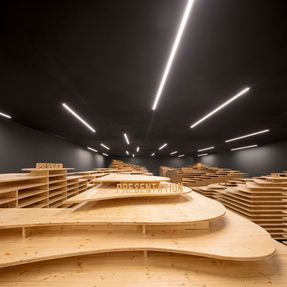
Megalithic Museum
MEGALITHIC MUSEUM
CVDB arquitectos + Tiago Filipe Santos + P-06 Atelier
ARCHITECTS
CVDB arquitectos, P-06 Atelier, Tiago Filipe Santos
MANUFACTURERS
Viabizzuno, CASTAN, Carmo
LANDSCAPE ARCHITECTURE
Bound Arquitectura Paisagista, Maria João Fonseca, Armando Ferreira
CLIENT
Mora Municipality
ENGINEERING
Projectual
EXHIBITION PROJECT MANAGER
Nuno Gusmão, Paulo Costa
MUSEOLOGY CONSULTANT
Leonor Rocha
COLLABORATING ARCHITECTS
Joana Barrelas, Rodolfo Reis, Eliza Borkowska, Elizabeta Vito, Hugo Nascimento, Ilaria Anselmi, Magdalena Czapluk
EXHIBITION PROJECT DESIGN DEVELOPMENT
Pedro Anjos
EXHIBITION PROJECT ARCHITECTURE DEVELOPMENT
Simão Botelho
TOTAL CONSTRUCTION COST
2.200.000,00 Euros
PROCEDURE
International Public Competition – 1st prize
ARCHITECTS IN CHARGE
Cristina Veríssimo, Diogo Burnay, Tiago Filipe Santos
EXHIBITION PROJECT
P-06 ATELIER
LOCATION
Mora, Portugal
CATEGORY
Museum, Restoration
Text description provided by architect.
The Megalithic Museum is located at Mora’s urban centre, close to a future public park. The town and region, are well known for its archaeological findings.
The museum intendeds to be a local and national reference and an important asset to the cultural regeneration of the town.
The old train station in Mora is an iconic building that is part of the town heritage. The building is deeply rooted in the long-lasting collective memory of Mora’ inhabitants and visitors.
The project clarifies and enhances the architectural value of the existing buildings, in a gesture of careful refurbishment.
The museum complex integrates the old train station, its warehouse and two new buildings. The new buildings are the main exhibition area (West) and a cafeteria (East).
The four buildings are connected through a continuous outdoor gallery that is located along the north side of the site.
The gallery resembles the linearity of the old train station dock. The gallery is the element that conceptually unifies the project, solving the circulation and the relation between all the different programmes.
The main entrance is located at the old train station building as well as the library, IT room and administration areas.
The warehouse was transformed into a multipurpose open space, being mainly an education workshop area.
The design, materials and techniques used in the refurbishment process respect the character of the existing constructions.
The Metallic white panels that rap around the gallery space and the new buildings, were cut out with a geometrical pattern that is an interpretation of Megalithic iconography - a conceptual leitmotif - that aggregates the project and bring light into the space through the day. At night, the museum glows in the dark.

























